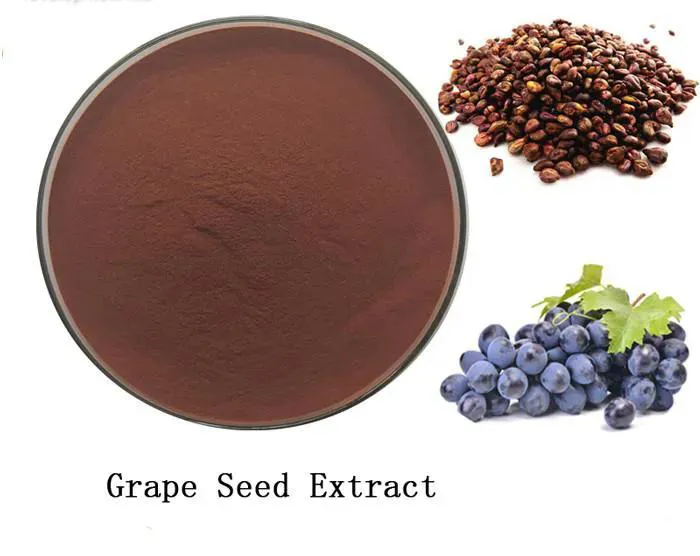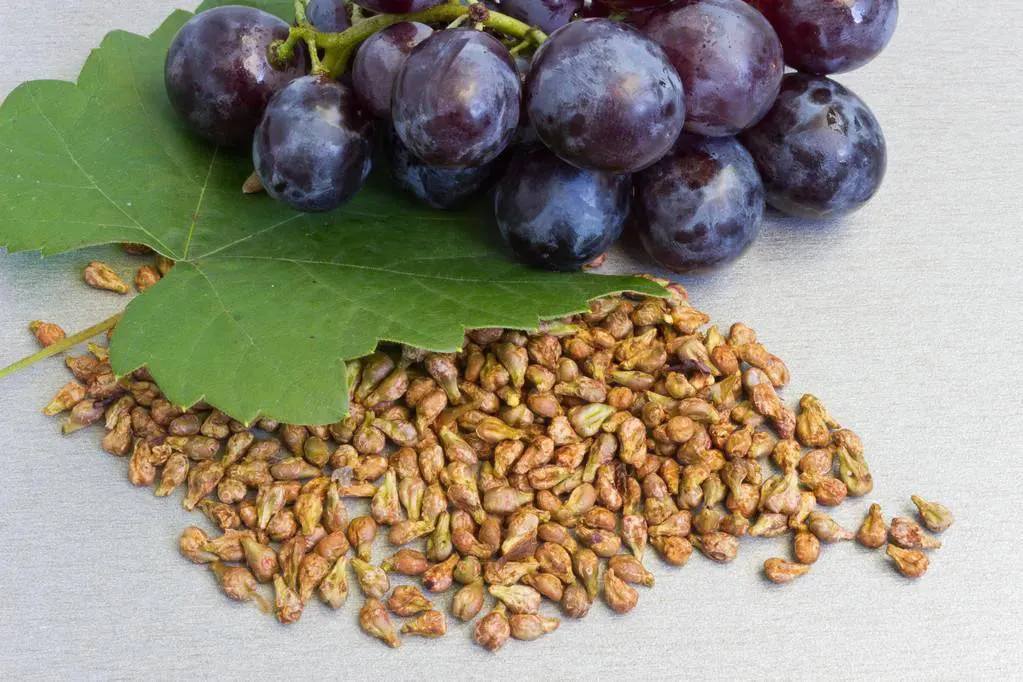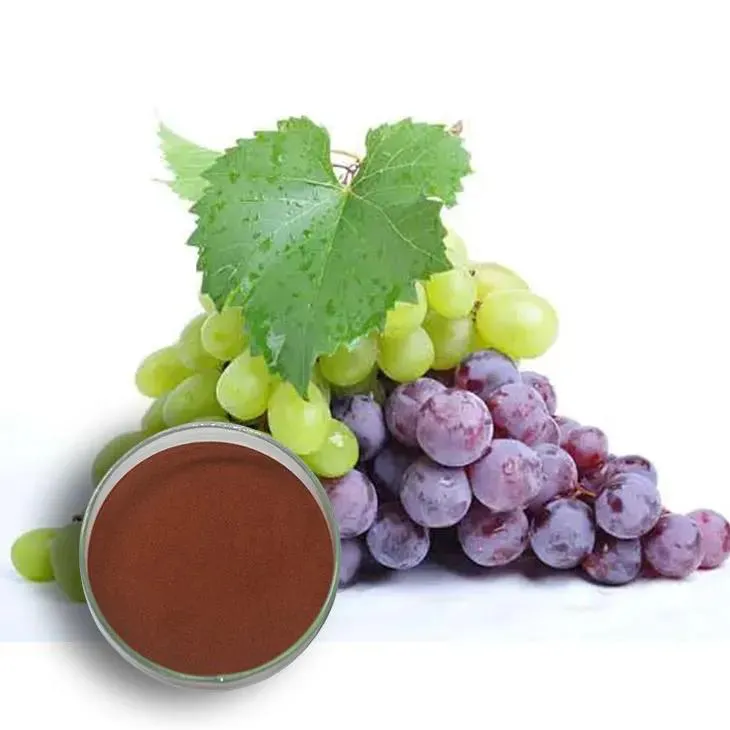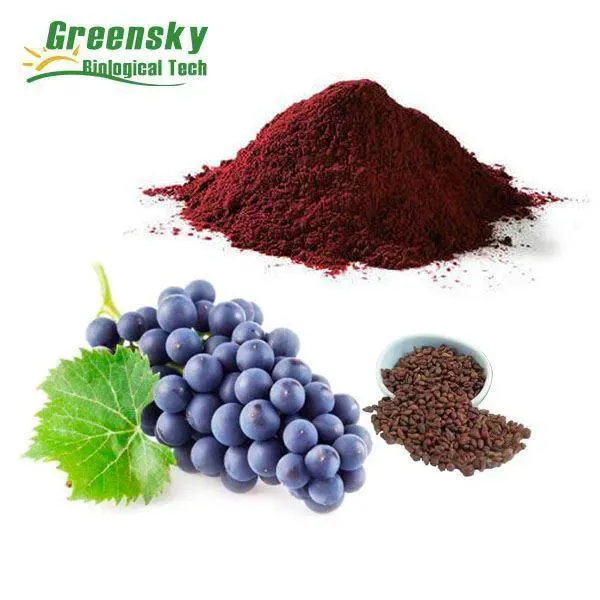- 0086-571-85302990
- sales@greenskybio.com
The Latin Name of Grape Seed Extract: A Key to Understanding Its Health Impact
2024-08-11

Introduction
Grape Seed Extract has emerged as a highly regarded component in the realm of health and wellness. It is often touted for its numerous potential health benefits. However, to truly understand the full scope of its impact on health, it is essential to look at its Latin name, Vitis vinifera. This Latin name is not just a scientific label but a gateway to a more comprehensive understanding of the extract's properties and how they can influence human health.

The Significance of Botanical Classification
Botanical classification is a fundamental system in the study of plants. It provides a structured framework for categorizing different plant species based on their characteristics. The Latin name Vitis vinifera places Grape Seed Extract within a specific botanical family, genus, and species. This classification is crucial as it helps in:
-
Identification: It allows for accurate identification of the plant source of the Grape Seed Extract. In a world where there are numerous plant species, having a precise Latin name ensures that there is no confusion about the origin of the extract. For example, different grape varieties may have slightly different properties, and the Latin name helps in differentiating the exact type of grape from which the seed extract is obtained.
-
Comparative Studies: Scientists can use the botanical classification to compare Vitis vinifera with other related plant species. This comparison can reveal similarities and differences in their chemical compositions, growth patterns, and potential health benefits. By understanding how grape seed extract is related to other plants within the same family or genus, researchers can gain insights into its unique properties.
-
Predicting Properties: The classification can also be used to predict certain properties of grape seed extract. Since plants within the same genus or family often share common characteristics, knowledge of the broader botanical group can give clues about the potential health benefits, chemical constituents, and even the optimal growing conditions for grapes used to produce the extract.

Unique Properties Revealed by the Classification
The classification of grape seed extract as Vitis vinifera reveals several unique properties:
Chemical Composition
Vitis vinifera grapes are known to contain a rich array of chemical compounds. Grape seed extract, in particular, is a concentrated source of several bioactive substances. These include:
-
Proanthocyanidins: These are powerful antioxidants that are highly concentrated in grape seed extract. Proanthocyanidins are part of a larger class of compounds known as flavonoids. Their antioxidant activity is crucial as it helps in neutralizing harmful free radicals in the body. Free radicals are unstable molecules that can cause damage to cells, leading to various health problems such as premature aging, cancer, and cardiovascular diseases. The presence of proanthocyanidins in grape seed extract, which is related to its classification as Vitis vinifera, is one of the main reasons for its antioxidant - related health benefits.
-
Resveratrol: Another important compound found in Vitis vinifera is resveratrol. Resveratrol has been the subject of numerous research studies due to its potential health - promoting properties. It has been shown to have anti - inflammatory, antioxidant, and even anti - aging effects. Although resveratrol is present in other parts of the grape as well, its presence in grape seed extract contributes to the overall health - enhancing profile of the extract. The fact that it is characteristic of Vitis vinifera further emphasizes the importance of the Latin name in understanding the properties of the extract.
-
Tocopherols: These are forms of vitamin E and are also found in grape seed extract. Tocopherols play an important role in maintaining the integrity of cell membranes and protecting cells from oxidative damage. Their presence in Vitis vinifera - derived grape seed extract adds to the extract's antioxidant capabilities.
Growth and Cultivation Characteristics
The classification of grapes as Vitis vinifera also gives insights into their growth and cultivation characteristics. For example:
-
Climate Requirements: Vitis vinifera grapes typically thrive in specific climate conditions. They are often associated with regions that have a Mediterranean - type climate, characterized by warm, dry summers and mild winters. These climate requirements can influence the chemical composition of the grapes and, consequently, the properties of the grape seed extract. Grapes grown in optimal climate conditions may have a higher concentration of bioactive compounds, which can enhance the health benefits of the extract.
-
Soil Preferences: Different grape varieties within the Vitis vinifera species may have specific soil preferences. The type of soil can affect the nutrient uptake of the grapes, which in turn can impact the content of beneficial compounds in the grape seed extract. For instance, grapes grown in well - drained, fertile soils may produce seeds with a more favorable chemical profile for health applications.

Antioxidant Benefits
The antioxidant properties of grape seed extract, closely related to its Vitis vinifera classification, offer a wide range of health benefits:
-
Cell Protection: Antioxidants in grape seed extract, such as proanthocyanidins, help protect cells from oxidative damage. This is crucial as oxidative stress can lead to the breakdown of cell membranes, DNA damage, and the malfunction of cellular components. By neutralizing free radicals, the extract can help maintain the integrity and normal function of cells throughout the body.
-
Anti - Aging Effects: Oxidative stress is also a major contributor to the aging process. The antioxidants in grape seed extract can combat this by reducing the damage caused by free radicals. This may result in a reduction in the appearance of wrinkles, improvement in skin elasticity, and a more youthful appearance overall. Additionally, on a cellular level, it can help slow down the aging process by protecting DNA and other cellular structures.
-
Disease Prevention: A strong antioxidant defense provided by grape seed extract can play a role in preventing various diseases. For example, it may help reduce the risk of cancer by preventing DNA mutations caused by free radicals. It can also contribute to cardiovascular health by preventing the oxidation of low - density lipoprotein (LDL) cholesterol, which is a key factor in the development of atherosclerosis.

Anti - Inflammatory Properties
Grape seed extract, with its origin in Vitis vinifera, also exhibits anti - inflammatory properties:
-
Inflammatory Response Modulation: The compounds in grape seed extract can modulate the body's inflammatory response. Inflammation is a natural defense mechanism of the body, but chronic inflammation can lead to various health problems such as arthritis, heart disease, and diabetes. Grape seed extract can help regulate the production of inflammatory mediators, such as cytokines, reducing excessive inflammation and promoting a more balanced immune response.
-
Joint Health: For individuals with joint problems, such as arthritis, the anti - inflammatory properties of grape seed extract can be beneficial. It may help reduce pain, swelling, and stiffness in the joints by reducing the inflammatory processes that occur in the joint tissues. This can potentially improve the quality of life for those suffering from joint - related disorders.
-
Gut Health: Inflammation in the gut can disrupt the normal functioning of the digestive system. Grape seed extract can help reduce gut inflammation, which may improve digestion, nutrient absorption, and overall gut health. This is important as a healthy gut is associated with a stronger immune system and better overall well - being.
Cardiovascular Benefits
The Vitis vinifera - derived grape seed extract offers several cardiovascular benefits:
-
Blood Pressure Regulation: Some studies have suggested that grape seed extract may help regulate blood pressure. It may do this by improving the function of blood vessels, making them more elastic and less prone to constriction. By reducing blood pressure, the risk of developing hypertension - related complications such as heart attacks and strokes can be decreased.
-
Cholesterol Management: As mentioned earlier, grape seed extract can prevent the oxidation of LDL cholesterol. Additionally, it may also help in reducing the levels of total cholesterol and triglycerides in the blood. By improving cholesterol management, it can contribute to a healthier cardiovascular profile.
-
Improved Blood Vessel Function: The extract can enhance the function of endothelial cells, which line the inside of blood vessels. Healthy endothelial function is crucial for proper blood flow and the prevention of blood clot formation. By promoting good endothelial function, grape seed extract can help maintain a healthy cardiovascular system.
Conclusion
In conclusion, the Latin name Vitis vinifera of grape seed extract is far more than just a scientific name. It is a key that unlocks a deeper understanding of the extract's health impact. Through its connection to botanical classification, we can uncover unique properties such as its chemical composition, growth characteristics, and how these relate to its antioxidant, anti - inflammatory, and cardiovascular benefits. As research on grape seed extract continues, the significance of its Latin name will likely remain a fundamental aspect in exploring and harnessing its full potential for human health.
FAQ:
What is the Latin name of grape seed extract?
The Latin name of grape seed extract is Vitis vinifera.
Why is the Latin name important for understanding the health impact of grape seed extract?
The Latin name is important as it is related to the botanical classification. This classification can reveal unique properties of grape seed extract, which in turn are linked to its health impacts such as antioxidant, anti - inflammatory, and cardiovascular benefits.
How is the Latin name related to the botanical classification of grape seed extract?
The Latin name Vitis vinifera is a part of the botanical classification system. It helps in categorizing the grapevine species precisely. This classification allows scientists to study the characteristics and properties that are specific to this particular type of plant, from which the grape seed extract is obtained.
What are the antioxidant benefits related to the Latin - named Vitis vinifera grape seed extract?
The Vitis vinifera grape seed extract contains various compounds. These compounds are associated with antioxidant benefits. For example, it may contain phenolic compounds like proanthocyanidins. These antioxidants can help in neutralizing free radicals in the body, reducing oxidative stress, and potentially protecting cells from damage.
How does the botanical classification of Vitis vinifera contribute to the anti - inflammatory properties of grape seed extract?
The botanical classification of Vitis vinifera helps in identifying the specific chemical constituents present in the grape seed extract. These constituents can interact with the body's inflammatory pathways. For instance, certain flavonoids found in Vitis vinifera - derived grape seed extract may inhibit the production of inflammatory mediators, thereby contributing to its anti - inflammatory properties.
Related literature
- The Health Benefits of Vitis vinifera Grape Seed Extract: A Review"
- "Vitis vinifera: Botany, Phytochemistry, and Health - Promoting Properties"
- "Antioxidant and Anti - Inflammatory Activities of Grape Seed Extract (Vitis vinifera): Mechanisms and Potential Applications"
- ▶ Hesperidin
- ▶ citrus bioflavonoids
- ▶ plant extract
- ▶ lycopene
- ▶ Diosmin
- ▶ Grape seed extract
- ▶ Sea buckthorn Juice Powder
- ▶ Beetroot powder
- ▶ Hops Extract
- ▶ Artichoke Extract
- ▶ Reishi mushroom extract
- ▶ Astaxanthin
- ▶ Green Tea Extract
- ▶ Curcumin Extract
- ▶ Horse Chestnut Extract
- ▶ Other Problems
- ▶ Boswellia Serrata Extract
- ▶ Resveratrol Extract
- ▶ Marigold Extract
- ▶ Grape Leaf Extract
- ▶ blog3
-
Avocado Extract Powder
2024-08-11
-
Agaricus Blazei Extract
2024-08-11
-
Tongkat Ali Extract
2024-08-11
-
Genistein
2024-08-11
-
Nutmeg Extract
2024-08-11
-
Bayberry Extract
2024-08-11
-
Mango flavored powder
2024-08-11
-
Red Wine Extract
2024-08-11
-
Acerola Extract
2024-08-11
-
Milk Thistle Extract
2024-08-11





















